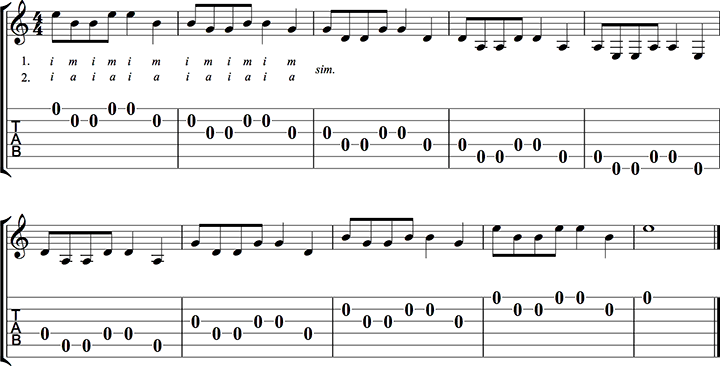Guitar Picking Exercises Pdf
Chops: IntermediateTheory: BeginnerLesson Overview:. Understand the basic elements of Travis picking. Develop several alternating bass patterns. Apply this fingerpicking concept to songs you already know.Travis picking is one of the most important accompaniment styles in country guitar, and it’s a vital component in any guitarist’s technique arsenal. Named after guitar great Merle Travis, this technique was adopted by tons of Merle’s disciples, perhaps most famously by Chet Atkins. Other modern guitar players, such as Tommy Emmanuel and Scotty Anderson, have also used this technique to great effect. Merle used a banjo thumbpick to get more punch out of his bass lines, however you can get away with using a bare thumb if you aren’t afraid to dig in a bit (the audio clips for this lesson have all been recorded without a thumbpick).
Another option would be to use hybrid picking, in which you play with a flatpick and fingers. Playing Travis style this way may require some right-hand pinky plucking, which could be a daunting task for those who have yet to train their little finger—a wise time investment, if you ask me.For those uninterested in playing country guitar, studying a bit of Travis picking is a great way to improve your syncopation and right-hand independence, regardless of genre. When it comes to learning a new guitar technique, my mantra is “absorb, adapt, assimilate.” Find a way to work this into your own personal sound, whether it’s country or death metal. You never know what kind of gigs are in the future.Ex. 1 shows a root-position C major chord. Merle’s use of the right-hand thumb is perhaps the most vital component of this style.
Notice how the thumb plays a root bass note on beat 1 and then brushes the chord’s 3 and 5 together on beat 2. On beat 3, the bass note shifts to the 5 of the chord. Use light palm damping to prevent extraneous ringing. This will also help separate the melody and accompaniment as we build this example up. Don’t rest your thumb on the 2nd string after brushing the 4th and 3rd strings because that will prevent you from placing a melody note there in the future. The thumb gesture should be almost circular, moving away from the strings after you brush them and back around to grab the next bass note.
Moving from the root to the 5 (either ascending or descending) is the general technique for applying Travis picking to a chord progression. With just this knowledge, you can try this exercise with any chord you know.Now we add a simple melody on top of our C chord. 2, the melody notes are all on downbeats. If this example is difficult for you, wait until you can play it confidently and in time before moving on to the next examples. Again, I use a bit of palm damping (not quite heavy metal palm muting) to get a clickier, percussive timbre out of the chord and bass line.
Guitar Picking Exercises Pdf Free
This contrast will be more noticeable with the presence of a melody. Not only does damping help separate the parts, it is also idiomatic to the style.Ex. 3 introduces a simple anticipation to the melody fromthe previous example. Focus on sustaining this melody as much as possible to give the illusion of accompaniment and melody. To insure you aren’t rushing, tap your foot on 2 and 4 (you’ll be lined up with the double-stop that you brush with the thumb), and make sure the notes on the upbeat are rhythmically defined.
(In other words, be confident about their placement.)Ex. 4 embellishes the simple idea in Fig. 3 with more syncopations and some basic ornamentation.
Practice slowly and carefully, as your natural tendency may be to rush the hammered note on beat 2. You want it to sound like eighth-notes and not a slide from D to C. If the rhythm isn’t confident, the picture doesn’t come out clearly—slow and steady wins the race!

Being able to hammer melody notes in time will also help you save a fingerstroke in tricky situations.